Ceramic Bearings
Table of Contents
Definition of Ceramic Bearings
Ceramic bearings are bearings that use ceramic rolling elements instead of steel. They are known for their high-speed capabilities and durability.
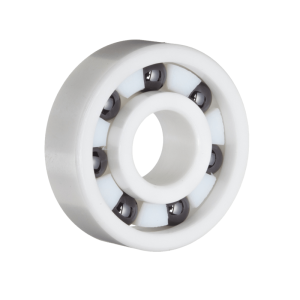
FHD Bearings is an ISO 9001:2015 certified manufacturing enterprise that stocks a full range of full ceramic bearings, hybrid ceramic bearings, and ceramic balls. With over 1,200 different bearing sizes and over 250K bearings in stock.
Materials of Ceramic Bearings
– Silicon nitride ceramics is superior to other materials due to its thermal shock resistance. It does not deteriorate at high temperatures, so it’s used for automotive engines and parts for gas turbines, including the turbocharger rotor.
– FHD offers a complete family of Silicon Nitride materials. These materials have the following key characteristics: No adhesive wear against steel, Twice as hard as tool steel, Good chemical resistance, and 60% less weight than steel.
– Zirconia Oxide has the highest strength and toughness at room temperature of all the advanced ceramic materials. The fine grain size allows for extremely smooth surfaces and sharp edges.
Applications include scissors, knives, slitters, pump shafts, metal-forming tools, fixtures, tweezers, wire drawing rings, bearing sleeves, and valves.
– FHD provides state-of-the-art materials manufactured by the most cost-effective processes. FHD Zirconia Oxide maintains efficient manufacturing facilities that support quick-turn prototype development and high-volume production.
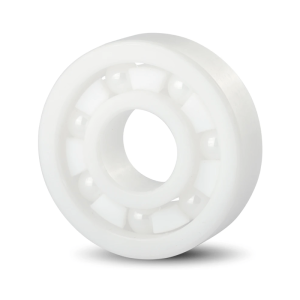
– Silicon carbide ceramics maintains its high mechanical strength in temperatures as high as 1,400C. It has higher chemical corrosion resistance than other ceramics.
– FHD offers a complete family of fully dense silicon carbide ceramics materials.
Alumina Oxide (Al2O3)
– Alumina Ceramics is the most widely used fine ceramics material. This material has superb material characteristics such as high electrical insulation, high mechanical strength, and high wear and chemical resistance.
– FHD provides state-of-the-art technical alumina ceramics manufacturing with the most cost-effective processes. FHD maintains efficient manufacturing facilities that support quick-turn prototype development and high-volume production.
Features of Ceramic Bearings

- High-Temperature Resistance: Ceramic bearings can withstand extreme temperatures, making them ideal for high-heat environments.
- Corrosion Resistance: They are highly resistant to corrosion, ensuring longevity even in harsh conditions.
- Lightweight: Ceramic bearings are significantly lighter than traditional steel bearings, reducing overall equipment weight.
- Low Friction: Minimal friction results in reduced energy consumption and increased efficiency.
- High-Speed Capability: They excel at high-speed operations due to lower friction and reduced heat generation.
- Longer Service Life: Ceramic materials offer exceptional durability, leading to extended bearing life.
- Precision: Ceramic bearings provide precise and consistent performance in critical applications.
Advantages of Ceramic Bearings
- Enhanced Performance: Improved efficiency and reduced wear in machinery.
- Reduced Maintenance: Longer service life means fewer replacements and lower maintenance costs.
- Energy Efficiency: Lower friction results in energy savings and reduced operating costs.
- Versatility: Suitable for a wide range of industries and applications.
- Increased Reliability: Dependable performance in challenging environments.
- Quiet Operation: Minimal vibration and noise contribute to a quieter work environment.
- Customization: Ceramic bearings can be tailored to specific application requirements.
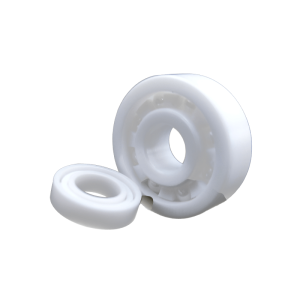
Types of Ceramic Bearings
Full Ceramic Bearings

Ceramic Ball Bearings
Full ceramic ball bearings constructed entirely of ceramic material. Inner/outer races and balls are made of either Silicon Nitride (Si3N4), Zirconium Oxide (ZrO2) or Silicon carbide ( Sic ).

Angular Contact Ceramic Ball Bearings
Angular contact ceramic ball bearing are designed for applications operating in extreme special environments where conventional bearings are not suitable for.

Thrust Ceramic Ball Bearings
Thrust ceramic ball bearing constructed entirely of ceramic material. Inner/outer races and balls are made of either Silicon Nitride(Si3N4), Zirconium Oxide (Zro2) orSilicon carbide (Sic)

Self-aligning Ceramic Ball Bearings
Self-aligning ceramic ball bearings have high temperature resistance, low cold resistance, high-pressure resistance and corrosion resistance, but have no magnetism and power insulation and oil resistance.
Ceramic Ball Bearings

Full ceramic ball bearings – Zirconia Oxide
Zirconia is inert to corrosive materials, with the exception of hydrofloric acid and hot concentrated sulfuric acid.Range in bore diameters from 2 mm to1060 mm.

Full ceramic ball bearings – Silicon Nitride
Silicon Nitride ceramic bearings have a high heat resistance with low friction.Range in bore diameters from 2 mm to 1060 mm.

Full ceramic ball bearings – Silicon Carbide
Silicon Carbide delivers incredibly high corrosion-resistance.Range in bore diameters from 2 mm to1060 mm.
Hybrid Ceramic Bearings

Hybrid Ceramic Deep Groove Ball Bearings
Standard hybrid ceramic bearings are single row ball bearings, available from .0937" through .875" bore sizes.

Hybrid Ceramic Flanged Bearings
Flanged hybrid ceramic bearings have a solid steelflange on the outer ring. This allows the bearing to be more easily located in a housing.

Hybrid Ceramic Cylindrical Roller Bearings
Separable bearings, suitable for high speeds, canaccommodate heavy radial loads and axialdisplacement. Commonly used in electric motors andin applications running under severe operatingconditions
Ceramic Ball

Silicon Nitride Ball (Si3N4)
High fatigue life, high temperature resistance, wear resistance,special for medical area.

Silicon Carbide Ball (SiC)
High hardness, corrosion resistance, ultra-high temperature resistance,special for medical area.

Zirconia Oxide Ball (ZrO2)
High hardness, corrosion resistance, ultra-high temperature resistance,special for medical area.

Alumina Oxide Ball (Al2O3)
Corrosion resistance, high hardness, high temperature resistance,special for valves.
Applications of Ceramic Bearings
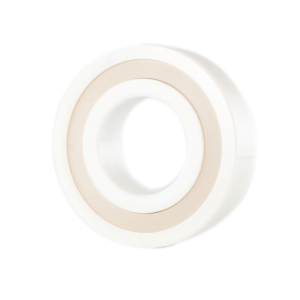
- High-Speed Machinery: Such as machine tools, electric motors, and aerospace equipment.
- Medical Devices: In precision medical equipment where reliability is critical.
- Automotive Industry: For applications like hybrid and electric vehicles, as well as racing cars.
- Industrial Pumps and Compressors: Where efficiency and reliability are vital.
- Wind Turbines: To handle the demanding conditions of wind power generation.
- Cycling and Sporting Equipment: In high-performance bicycles, skateboards, and sports machinery.
- Electronics Manufacturing: For precise positioning in semiconductor production.
- Textile Machinery: To improve efficiency in textile manufacturing processes.
- Food and Beverage Processing: Where corrosion resistance is essential.
Key Manufacturing Process of Ceramic Bearings
Raw Material Preparation
Material Selection: High-quality ceramic powders such as silicon nitride (Si3N4) or zirconia (ZrO2) are selected based on the application needs.
Material Mixing: The ceramic powders are mixed with additives like yttria or alumina and organic binders to improve mechanical properties and processing behavior.
Forming Process
Injection Molding: The mixed ceramic powder is fed into an injection molding machine, where it’s molded into the shape of the bearing elements.
Isostatic Pressing: In some cases, isostatic pressing may be used to ensure uniform density and material properties.
Green Machining
Pre-Sintering Machining: Some features like grooves and chamfers are machined into the green (un-sintered) state of the ceramic parts.
Sintering
Debinding: Organic binders are removed at low temperatures in a controlled environment.
High-Temperature Sintering: The parts are sintered in a high-temperature furnace under a controlled atmosphere to achieve full density and desired material properties.
Post-Sintering Operations
Grinding: High-precision grinding is carried out to achieve the final dimensions and surface finish.
Polishing: Components are polished to minimize friction and maximize lifespan.


FAQ - Frequently Asked Questions
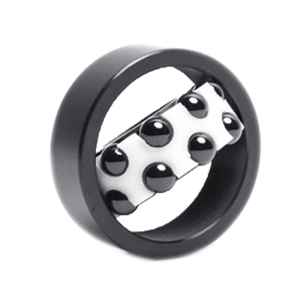
Ceramic bearings are bearings that use ceramic rolling elements instead of steel. They are known for their high-speed capabilities and durability.
Ceramic bearings offer lower friction, higher stiffness, and longer lifespan compared to steel bearings.
There are two main types: full ceramic bearings and hybrid ceramic bearings.
Hybrid ceramic bearings have ceramic balls but steel inner and outer rings.
They are commonly used in high-speed applications like aerospace, medical devices, and high-performance automotive.
Ceramic bearings have better heat resistance compared to steel bearings.
Yes, ceramic materials are generally corrosion-resistant.
While ceramic bearings are stiff, their load capacity is generally lower than that of steel bearings.
They offer lower vibration levels due to their high stiffness.
No, ceramic bearings are non-magnetic.
Ceramic bearings are generally more expensive than steel bearings.
Their lifespan is longer than steel bearings, but it varies depending on the application.
It is generally not recommended to repair ceramic bearings; replacement is usually the best option.
Look for ISO certifications and other industry-specific standards.
Installation procedures are similar to those of steel bearings, but special care must be taken to avoid damaging the ceramic elements.
Ceramic bearings often require less lubrication than steel bearings.
They are not suitable for all applications, especially those requiring high load capacities.
Use specialized testing equipment to measure parameters like roundness, stiffness, and load capacity.
Standard B2B payment terms T/T, L/C are accepted.
Look for suppliers with a strong track record, certifications, and transparent communication channels.
Installation and Maintenance of Ceramic Bearings
Installation
- Cleanliness is Key: Before starting the installation process, ensure that the work area and your hands are clean to prevent any contamination.
- Proper Tools: Use the appropriate tools for handling ceramic bearings. Avoid using tools with sharp edges that may damage the bearing.
- Lubrication: Ceramic bearings typically require less lubrication compared to traditional steel bearings. Apply a minimal amount of high-quality lubricant, ensuring it’s compatible with ceramic materials.
- Mounting: Carefully place the ceramic bearing onto the shaft or housing, ensuring it’s a proper fit. Use a soft mallet or press to avoid excessive force.
- Alignment: Proper alignment is crucial. Ensure the bearing is aligned correctly with the load to prevent unnecessary stress.
- Tightening: When tightening, use a torque wrench to apply the recommended torque. Avoid over-tightening, as it can damage the bearing or the equipment.
- Check for Smooth Rotation: After installation, check for smooth rotation. Any unusual noise or resistance may indicate a problem.
Maintenance:
- Regular Inspections: Implement a routine inspection schedule to check for signs of wear, contamination, or damage. This includes checking for any unusual noise during operation.
- Lubrication: Reapply lubrication as needed. Ceramic bearings generally require less lubrication, but it’s essential to maintain a thin film of lubricant to reduce friction.
- Cleanliness: Keep the bearing and surrounding components clean. Any contamination can accelerate wear and reduce the bearing’s lifespan.
- Temperature Control: Monitor operating temperatures. Excessive heat can impact ceramic bearings. Ensure that the operating environment remains within recommended temperature ranges.
- Replace Damaged Bearings: If any damage or signs of wear are detected during inspections, replace the bearing promptly. Continuing to use a damaged bearing can lead to more significant issues.
- Use Quality Seals: If your application allows, use quality seals to protect the bearing from contamination. This is especially important in harsh environments.
- Record Keeping: Maintain records of maintenance and inspections. This will help track the bearing’s performance over time and plan for replacements.
- Training: Ensure your maintenance personnel are trained to handle ceramic bearings correctly. Proper handling and maintenance practices are vital to the bearing’s longevity.

Related Posts
Si3N4 Ceramic Bearings Comprehensive Guide
Table of Contents Categories Si3N4 Ceramic Bearings Comprehensive Guide Silicon...
Read MoreCeramic Bearings: Beyond Traditional Performance
Categories Ceramic Bearings: Beyond Traditional Performance Table of Contents Ceramic...
Read MoreThe Comprehensive Guide to Ceramic Bearings: A Paradigm Shift in Mechanical Engineering
The Comprehensive Guide to Ceramic Bearings: A Paradigm Shift in...
Read MoreSmooth and Silent: Exploring the Advantages of Ceramic Bearings over Steel Bearings
Smooth and Silent: Exploring the Advantages of Ceramic Bearings over...
Read More


